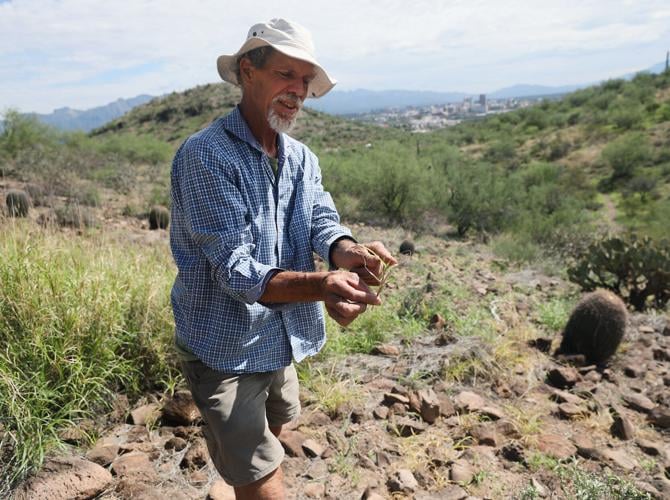Southern Arizona’s weed warriors just got more ammunition for their fight against buffelgrass in the Tucson Mountains.
U.S. Rep. Raúl Grijalva and other officials gathered Wednesday at the base of “A” Mountain to highlight $100,000 in new funding to help get rid of the invasive grass on Tumamoc Hill.
“I consider it a down payment,” the Democrat from Tucson said. “This first installment — in what I hope to be a consistent installment of resources for the campaign — is deserved and its overdue.”
The money will be used to treat up to 60 acres of buffelgrass on the eastern flank of Tumamoc starting next month, said Kim Franklin, conservation science manager for the Arizona-Sonora Desert Museum.
Digging is prohibited on the hill because of the large number of cultural sites there, so contract crews will fan out to spray the weeds with the popular herbicide glyphosate.
The matching grant was actually announced last year, but the funding just arrived, Franklin said.
The federal government supplied half the money. The rest came from a diverse coalition of 22 stakeholders in what is known as the Sonoran Desert Cooperative Weed Management Area.
The Desert Museum leads the partnership, which includes local, state and federal agencies, the Tohono O’odham Nation, the University of Arizona, the Freeport-McMoRan mining company and a host of conservation nonprofits, neighborhood associations and volunteer weed pulling groups.
Buffelgrass is native to Africa and Asia, where it populates grasslands that burn frequently as part of the natural ecological cycle.
The hardy, fast-growing perennial was planted widely in Arizona starting in the 1930s to curb erosion, provide forage for livestock and decorate some urban landscapes.
It has since exploded out of control, spreading even in dry years to crowd out native grasses and fuel once-rare wildfires that ravage saguaros, palo verdes and other desert plants not adapted to such things.
“It’s trying to convert the landscape. That’s what species do,” said Perry Grissom, restoration ecologist at Saguaro National Park.
By some estimates, buffelgrass now covers as much as 5,000 acres in the Tucson area alone. About 2,000 acres of that can be found in Saguaro National Park, where aerial spraying and volunteer weed-pullers have at least kept the problem from getting worse.
Franklin said she is no big fan of herbicide, but when applied correctly it’s a crucial tool. Without it, she said, “we’d have Buffelgrass National Park instead of Saguaro National Park.”
Wednesday’s news conference drew about 30 people, including several volunteers who had just returned from pulling weeds in the desert. The event was held in the lower parking lot at Sentinel Peak Park, next to a hillside dotted with bright green clumps of buffelgrass.
“It’s kind of ironic to see all that green and not get to appreciate it,” said Debra Colodner, director of conservation education and science for the Desert Museum.
The slopes of Tumamoc Hill are covered with about 200 acres of the stuff. Colodner said it will take about 10 years of “intensive treatment” to bring the weeds under control there.
The plant will probably never be eliminated completely, but it could be reduced from a serious threat to an annual maintenance issue, she said.
The fight against invasive weeds has been a real grassroots effort so far, Grijalva said. “The consistent force behind the eradication efforts (has) been volunteers and the organizations that have sponsored them.”
Now it’s time for the federal government to step up and do its part, he said.
With just $4 million, roughly one-tenth of what the U.S. Forest Service spent to contain the Bighorn Fire in the Catalinas in 2020, nearly every acre of buffelgrass in the Tucson area could be treated and the desert restored, Grijalva said.
So far, though, the 10-term congressman has had to work hard to convince even friendly administrations to make the war on weeds a priority.
“It’s hard sometimes to convince people that grass is a threat — a threat (of) fire, a threat to biodiversity, a threat to species and a threat to the landscape that we all love and are familiar with and cherish,” Grijalva said. “It is a threat, and we need to approach it as a threat.”





